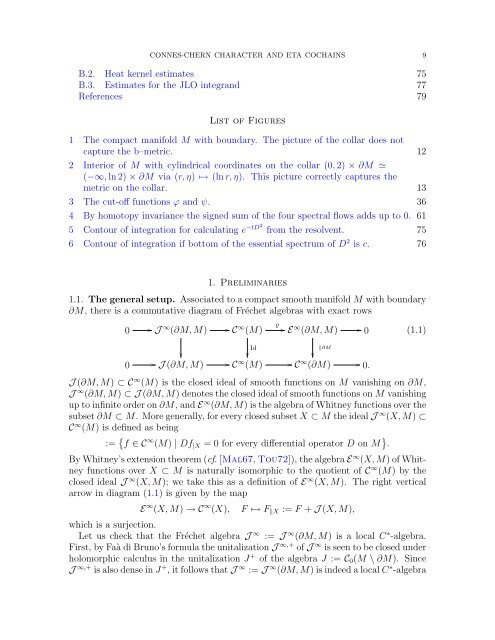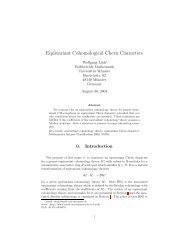Connes-Chern Character for Manifolds with Boundary and ETA ...
Connes-Chern Character for Manifolds with Boundary and ETA ...
Connes-Chern Character for Manifolds with Boundary and ETA ...
Create successful ePaper yourself
Turn your PDF publications into a flip-book with our unique Google optimized e-Paper software.
CONNES-CHERN CHARACTER AND <strong>ETA</strong> COCHAINS 9<br />
B.2. Heat kernel estimates 75<br />
B.3. Estimates <strong>for</strong> the JLO integr<strong>and</strong> 77<br />
References 79<br />
List of Figures<br />
1 The compact manifold M <strong>with</strong> boundary. The picture of the collar does not<br />
capture the b–metric. 12<br />
2 Interior of M <strong>with</strong> cylindrical coordinates on the collar (0, 2) × ∂M ≃<br />
(−∞, ln 2) × ∂M via (r, η) ↦→ (ln r, η). This picture correctly captures the<br />
metric on the collar. 13<br />
3 The cut-off functions ϕ <strong>and</strong> ψ. 36<br />
4 By homotopy invariance the signed sum of the four spectral flows adds up to 0. 61<br />
5 Contour of integration <strong>for</strong> calculating e −tD2 from the resolvent. 75<br />
6 Contour of integration if bottom of the essential spectrum of D 2 is c. 76<br />
1. Preliminaries<br />
1.1. The general setup. Associated to a compact smooth manifold M <strong>with</strong> boundary<br />
∂M, there is a commutative diagram of Fréchet algebras <strong>with</strong> exact rows<br />
0 J ∞ (∂M, M) C ∞ (M)<br />
Id<br />
ϱ<br />
E ∞ (∂M, M)<br />
0 J (∂M, M) C ∞ (M) C ∞ (∂M) 0.<br />
‖∂M<br />
0<br />
(1.1)<br />
J (∂M, M) ⊂ C ∞ (M) is the closed ideal of smooth functions on M vanishing on ∂M,<br />
J ∞ (∂M, M) ⊂ J (∂M, M) denotes the closed ideal of smooth functions on M vanishing<br />
up to infinite order on ∂M, <strong>and</strong> E ∞ (∂M, M) is the algebra of Whitney functions over the<br />
subset ∂M ⊂ M. More generally, <strong>for</strong> every closed subset X ⊂ M the ideal J ∞ (X, M) ⊂<br />
C ∞ (M) is defined as being<br />
:= { f ∈ C ∞ (M) | Df |X = 0 <strong>for</strong> every differential operator D on M } .<br />
By Whitney’s extension theorem (cf. [Mal67, Tou72]), the algebra E ∞ (X, M) of Whitney<br />
functions over X ⊂ M is naturally isomorphic to the quotient of C ∞ (M) by the<br />
closed ideal J ∞ (X, M); we take this as a definition of E ∞ (X, M). The right vertical<br />
arrow in diagram (1.1) is given by the map<br />
E ∞ (X, M) → C ∞ (X),<br />
F ↦→ F ‖X := F + J (X, M),<br />
which is a surjection.<br />
Let us check that the Fréchet algebra J ∞ := J ∞ (∂M, M) is a local C ∗ -algebra.<br />
First, by Faà di Bruno’s <strong>for</strong>mula the unitalization J ∞,+ of J ∞ is seen to be closed under<br />
holomorphic calculus in the unitalization J + of the algebra J := C 0 (M \ ∂M). Since<br />
J ∞,+ is also dense in J + , it follows that J ∞ := J ∞ (∂M, M) is indeed a local C ∗ -algebra

















